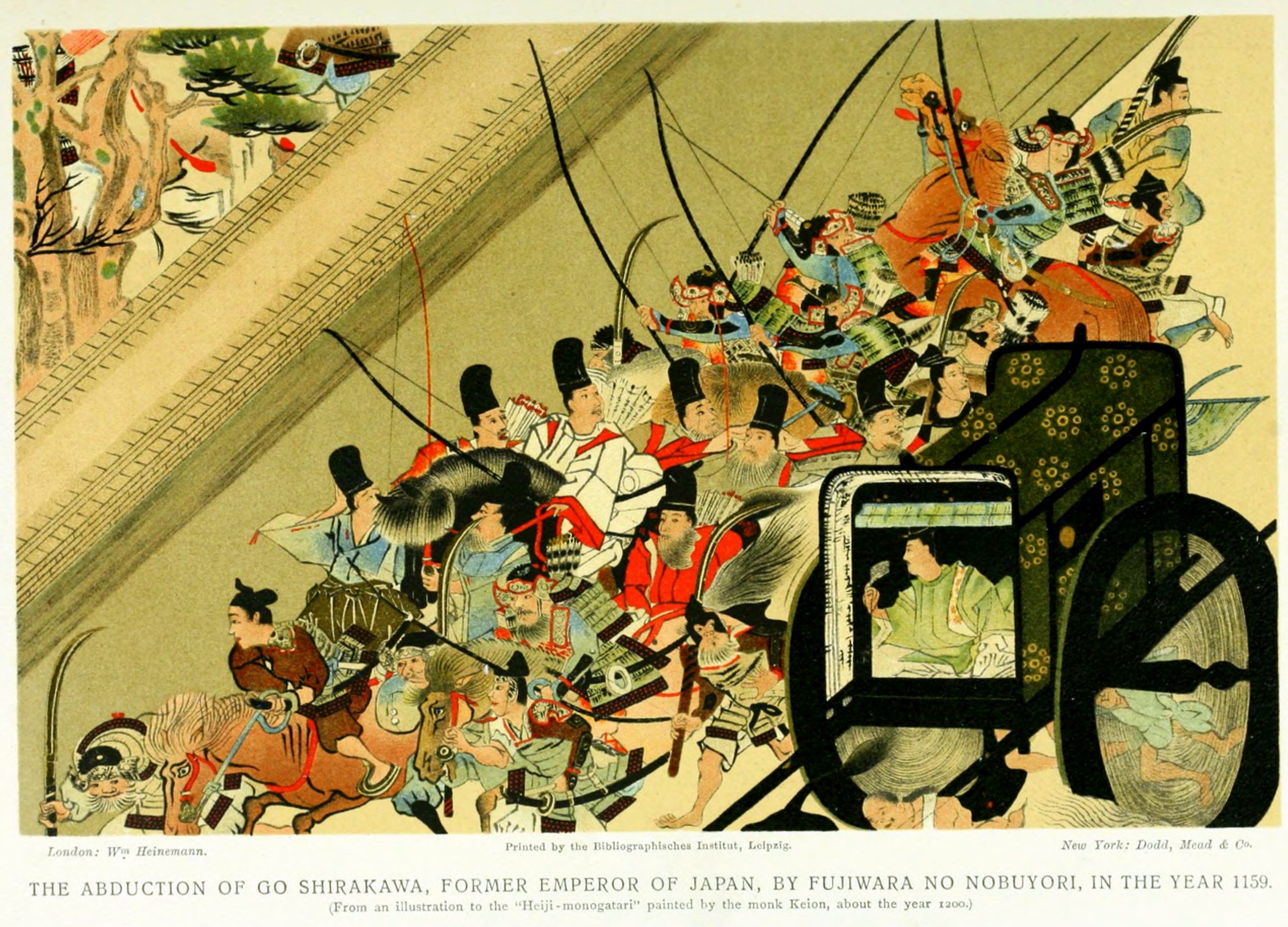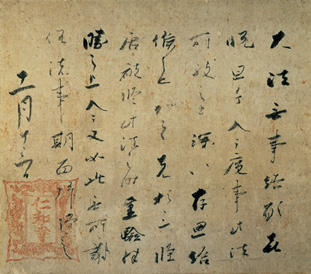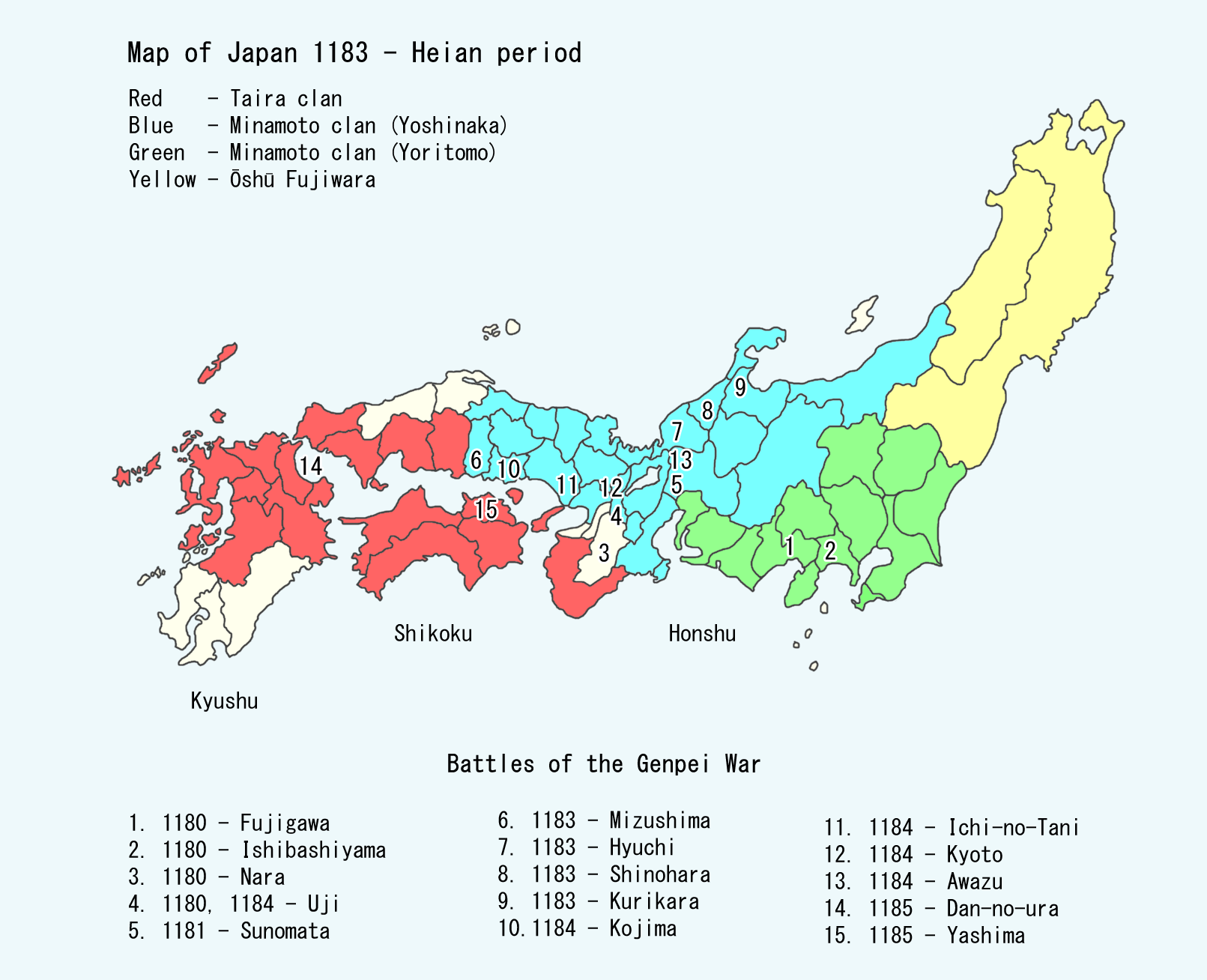|
Kiyomori
was a military leader and '' kugyō'' of the late Heian period of Japan. He established the first samurai-dominated administrative government in the history of Japan. Early life Kiyomori was born in Heian-kyō, Japan, in 1118 as the first son of Taira no Tadamori, who was the head of the Taira clan. It has been speculated that Kiyomori was actually an illegitimate son of Emperor Shirakawa. His mother, Gion no Nyogo, was a palace servant according to ''The Tale of the Heike''. Family * Father: Taira no Tadamori * Mother: Gion no Nyogo (d. 1147) *Concubines and regents: **Wife: N/A *** Taira no Shigemori *** Taira no Munemori *** Taira no Tomomori *** Taira no Tokuko *** Taira no Shigehira Career After the death of his father in 1159, Kiyomori assumed control of the Taira clan and ambitiously entered the political realm in which he had previously only held a minor post. Before that though, in 1156, he and Minamoto no Yoshitomo, head of the Minamoto clan, suppressed the r ... [...More Info...] [...Related Items...] OR: [Wikipedia] [Google] [Baidu] |
The Tale Of The Heike
is an epic account compiled prior to 1330 of the struggle between the Taira clan and Minamoto clan for control of Japan at the end of the 12th century in the Genpei War (1180–1185). Heike () refers to the Taira (), ''hei'' being the ''on'yomi'' reading of the first ''kanji'' and "ke" () means family. Note that in the title of the Genpei War, "hei" is in this combination read as "pei" and the "gen" () is the first kanji used in the Minamoto (also known as "Genji" which is also pronounced using ''on'yomi'', for example as in '' The Tale of Genji'') clan's name. It has been translated into English at least five times, the first by Arthur Lindsay Sadler in 1918–1921. A complete translation in nearly 800 pages by Hiroshi Kitagawa & Bruce T. Tsuchida was published in 1975. Also translated by Helen McCullough in 1988. An abridged translation by Burton Watson was published in 2006. In 2012, Royall Tyler completed his translation, which seeks to be mindful of the performance s ... [...More Info...] [...Related Items...] OR: [Wikipedia] [Google] [Baidu] |
Taira No Kiyomori
was a military leader and ''kugyō'' of the late Heian period of Japan. He established the first samurai-dominated administrative government in the history of Japan. Early life Kiyomori was born in Heian-kyō, Japan, in 1118 as the first son of Taira no Tadamori, who was the head of the Taira clan. It has been speculated that Kiyomori was actually an illegitimate son of Emperor Shirakawa. His mother, Gion no Nyogo, was a palace servant according to '' The Tale of the Heike''. Family * Father: Taira no Tadamori * Mother: Gion no Nyogo (d. 1147) *Concubines and regents: **Wife: N/A *** Taira no Shigemori *** Taira no Munemori *** Taira no Tomomori *** Taira no Tokuko *** Taira no Shigehira Career After the death of his father in 1159, Kiyomori assumed control of the Taira clan and ambitiously entered the political realm in which he had previously only held a minor post. Before that though, in 1156, he and Minamoto no Yoshitomo, head of the Minamoto clan, suppressed ... [...More Info...] [...Related Items...] OR: [Wikipedia] [Google] [Baidu] |
Go-Shirakawa
was the 77th emperor of Japan, according to the traditional order of succession. His de jure reign spanned the years from 1155 through 1158, though arguably he effectively maintained imperial power for almost thirty-seven years through the ''insei'' system – scholars differ as to whether his rule can be truly considered part of the ''insei'' system, given that the Hōgen Rebellion undermined the imperial position. However, it is broadly acknowledged that by politically outmaneuvering his opponents, he attained greater influence and power than the diminished authority of the emperor's position during this period would otherwise allow. Posthumously, this 12th-century sovereign was named after the 11th-century Emperor Shirakawa. ''Go-'' (後), translates literally as "later"; and thus, he is sometimes called the "Later Emperor Shirakawa", or in some older sources, may be identified as "Shirakawa, the second" or as "Shirakawa II". Unusually, the years of Go-Shirakawa's reign are ... [...More Info...] [...Related Items...] OR: [Wikipedia] [Google] [Baidu] |
Minamoto No Yoritomo
was the founder and the first shogun of the Kamakura shogunate of Japan, ruling from 1192 until 1199.Nussbaum, Louis-Frédéric. (2005). "Minamoto no Yoriie" in . He was the husband of Hōjō Masako who acted as regent (''shikken'') after his death. Yoritomo was the son of Minamoto no Yoshitomo and belonged to Seiwa Genji's prestigious Kawachi Genji family. After setting himself the rightful heir of the Minamoto clan, he led his clan against the Taira clan from his capital in Kamakura, beginning the Genpei War in 1180. After five years of war, he finally defeated the Taira clan in the Battle of Dan-no-ura in 1185. Yoritomo thus established the supremacy of the warrior samurai caste and the first shogunate ('' bakufu'') at Kamakura, beginning the feudal age in Japan, which lasted until the mid-19th century. Early life Yoritomo was the third son of Minamoto no Yoshitomo, heir of the Minamoto (Seiwa Genji) clan, and his official wife, Yura-Gozen, daughter of Fujiwara no Su ... [...More Info...] [...Related Items...] OR: [Wikipedia] [Google] [Baidu] |
Emperor Takakura
was the 80th emperor of Japan, according to the traditional order of succession. His reign spanned the years from 1168 through 1180. Genealogy Before his ascension to the Chrysanthemum Throne, his personal name (his ''imina'') was Norihito''-shinnō'' (憲仁親王). He was also known as Nobuhito''-shinnō''. Takakura was the fourth son of Emperor Go-Shirakawa, and thus uncle to his predecessor, Emperor Rokujō. His mother was Empress Dowager Taira no Shigeko, the younger sister of Taira no Tokiko, the concubine of Taira no Kiyomori. His empress consort was Taira no Tokuko (later Empress Dowager Kenrei), the regent of Taira no Kiyomori, and thus his first cousin (as his mother and Tokuko's mothers were sisters). * Empress consort: Taira no Tokuko (平徳子) – later Kenreimon-in ** First Son: Imperial Prince Tokihito (言仁親王) – later Emperor Antoku * Lady-in-waiting: Bōmon Shokushi (坊門殖子; 1157–1228) later Shichijō-in (七条院), Bomon Nobutaka's daug ... [...More Info...] [...Related Items...] OR: [Wikipedia] [Google] [Baidu] |
Taira Clan
The Taira was one of the four most important clans that dominated Japanese politics during the Heian, Kamakura and Muromachi Periods of Japanese history – the others being the Fujiwara, the Tachibana, and the Minamoto. The clan is divided into four major groups, named after the emperor they descended from: Kanmu Heishi, Ninmyō Heishi, Montoku Heishi, and Kōkō Heishi. The clan is commonly referred to as or , using the character's On'yomi for ''Taira'', while means " clan", and is used as a suffix for "extended family". History Along with the Minamoto, Taira was one of the honorary surnames given by the emperors of the Heian Period (794–1185 CE) to their children and grandchildren who were not considered eligible for the throne. The clan was founded when the Imperial Court grew too large, and the emperor ordered that the descendants of previous emperors from several generations ago would no longer be princes, but would instead be given noble surnames ... [...More Info...] [...Related Items...] OR: [Wikipedia] [Google] [Baidu] |
Taira No Tokuko
The Taira was one of the four most important clans that dominated Japanese politics during the Heian, Kamakura and Muromachi Periods of Japanese history – the others being the Fujiwara, the Tachibana, and the Minamoto. The clan is divided into four major groups, named after the emperor they descended from: Kanmu Heishi, Ninmyō Heishi, Montoku Heishi, and Kōkō Heishi. The clan is commonly referred to as or , using the character's On'yomi for ''Taira'', while means "clan", and is used as a suffix for "extended family". History Along with the Minamoto, Taira was one of the honorary surnames given by the emperors of the Heian Period (794–1185 CE) to their children and grandchildren who were not considered eligible for the throne. The clan was founded when the Imperial Court grew too large, and the emperor ordered that the descendants of previous emperors from several generations ago would no longer be princes, but would instead be given noble surnames and rank ... [...More Info...] [...Related Items...] OR: [Wikipedia] [Google] [Baidu] |
Taira
The Taira was one of the four most important clans that dominated Japanese politics during the Heian, Kamakura and Muromachi Periods of Japanese history – the others being the Fujiwara, the Tachibana, and the Minamoto. The clan is divided into four major groups, named after the emperor they descended from: Kanmu Heishi, Ninmyō Heishi, Montoku Heishi, and Kōkō Heishi. The clan is commonly referred to as or , using the character's On'yomi for ''Taira'', while means "clan", and is used as a suffix for " extended family". History Along with the Minamoto, Taira was one of the honorary surnames given by the emperors of the Heian Period (794–1185 CE) to their children and grandchildren who were not considered eligible for the throne. The clan was founded when the Imperial Court grew too large, and the emperor ordered that the descendants of previous emperors from several generations ago would no longer be princes, but would instead be given noble surnames and ra ... [...More Info...] [...Related Items...] OR: [Wikipedia] [Google] [Baidu] |
Taira No Kiyomori Kao
The Taira was one of the four most important clans that dominated Japanese politics during the Heian, Kamakura and Muromachi Periods of Japanese history – the others being the Fujiwara, the Tachibana, and the Minamoto. The clan is divided into four major groups, named after the emperor they descended from: Kanmu Heishi, Ninmyō Heishi, Montoku Heishi, and Kōkō Heishi. The clan is commonly referred to as or , using the character's On'yomi for ''Taira'', while means " clan", and is used as a suffix for "extended family". History Along with the Minamoto, Taira was one of the honorary surnames given by the emperors of the Heian Period (794–1185 CE) to their children and grandchildren who were not considered eligible for the throne. The clan was founded when the Imperial Court grew too large, and the emperor ordered that the descendants of previous emperors from several generations ago would no longer be princes, but would instead be given noble surnames and ra ... [...More Info...] [...Related Items...] OR: [Wikipedia] [Google] [Baidu] |
Heian Period
The is the last division of classical Japanese history, running from 794 to 1185. It followed the Nara period, beginning when the 50th emperor, Emperor Kanmu, moved the capital of Japan to Heian-kyō (modern Kyoto). means "peace" in Japanese. It is a period in Japanese history when the Chinese influences were in decline and the national culture matured. The Heian period is also considered the peak of the Japanese imperial court and noted for its art, especially poetry and literature. Two types of Japanese script emerged, including katakana, a phonetic script which was abbreviated into hiragana, a cursive alphabet with a unique writing method distinctive to Japan. This gave rise to Japan's famous vernacular literature, with many of its texts written by court women who were not as educated in Chinese compared to their male counterparts. Although the Imperial House of Japan had power on the surface, the real power was in the hands of the Fujiwara clan, a powerful aristocr ... [...More Info...] [...Related Items...] OR: [Wikipedia] [Google] [Baidu] |
History Of Japan
The first human inhabitants of the Japanese archipelago have been traced to prehistoric times around 30,000 BC. The Jōmon period, named after its cord-marked pottery, was followed by the Yayoi period in the first millennium BC when new inventions were introduced from Asia. During this period, the first known written reference to Japan was recorded in the Chinese '' Book of Han'' in the first century AD. Around the 3rd century BC, the Yayoi people from the continent immigrated to the Japanese archipelago and introduced iron technology and agricultural civilization. Because they had an agricultural civilization, the population of the Yayoi began to grow rapidly and ultimately overwhelmed the Jōmon people, natives of the Japanese archipelago who were hunter-gatherers. Between the fourth to ninth century, Japan's many kingdoms and tribes gradually came to be unified under a centralized government, nominally controlled by the Emperor of Japan. The imperial dynasty establishe ... [...More Info...] [...Related Items...] OR: [Wikipedia] [Google] [Baidu] |
Taira No Tadamori
was the head of the Taira clan. He was son of Taira no Masamori, and father of Taira no Kiyomori. Tadamori was also governor of the provinces of Harima, Ise, Bizen, and Tajima. He consolidated the influence of the Taira clan at the Imperial Court, and is said to have been the first samurai to serve the Emperor directly, at Court. As a servant of the Court, Tadamori waged campaigns, beginning in 1129, against pirates on the coasts of San'yōdō and Nankaidō. He also served his own clan in battling the warrior monks of Nara and of Mount Hiei. Tadamori is also credited with the construction of the Rengeō-in, a major and now-famous temple in Kyoto, which includes the longest wooden building in the world, the Sanjūsangen-dō. Tadamori was granted the governorship of Tajima province as a reward for completing this project. Family * Father: Taira no Masamori * Wife: Gion no Nyogo (?-1147) * Sons: ** Taira no Kiyomori was a military leader and ''kugyō'' of the late Heian ... [...More Info...] [...Related Items...] OR: [Wikipedia] [Google] [Baidu] |








